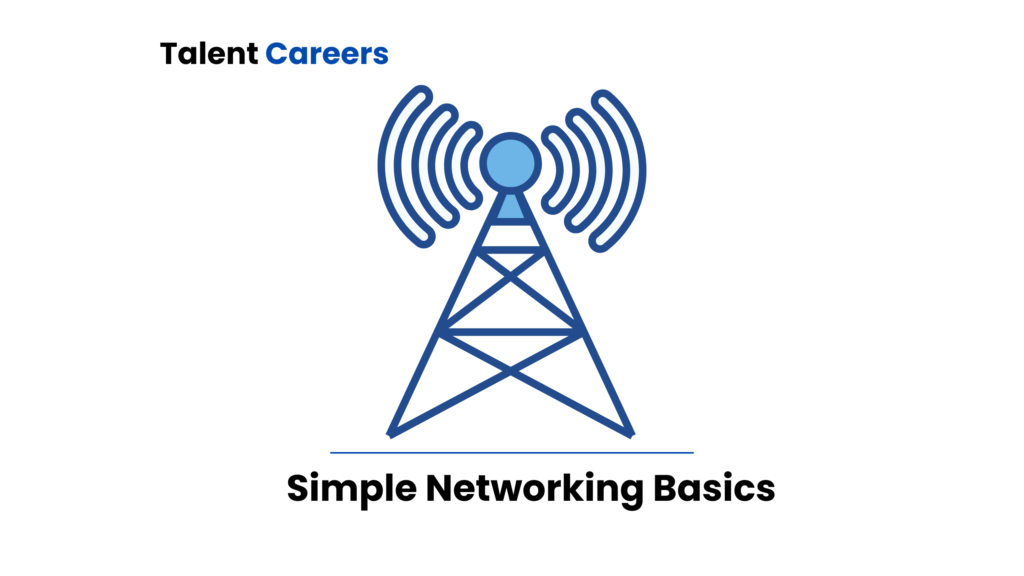Introduction
Networking Basics – Understanding basic networking concepts is essential in today’s tech-driven world. Networking skills open doors to various IT roles and help you make sense of how devices connect and communicate. In this guide, we’ll explore the 10 networking basics concepts every beginner should know. This guide is written in simple, beginner-friendly English to make learning networking easy and accessible.

| Join Our WhatsApp Community | CLICK HERE |
| Join Our Instagram Community | CLICK HERE |
Table of Contents
1. What is Networking? (Basic Definition)
Networking refers to connecting computers, phones, and other devices so they can share resources, like the internet or files. In simple terms, networking allows devices to communicate, making it possible to share information within a home or across the world. When we talk about networking, we refer to the entire setup, from devices to cables, that allows communication to happen.
2. IP Address Explained for Beginners
An IP address is a unique digital code assigned to each device connected to a network. Think of it as your device’s unique address. Without an IP address, your device couldn’t receive data or send it back to the internet. There are two types:
- IPv4 (older and limited in number)
- IPv6 (newer and more plentiful)
Understanding IP addresses is a crucial part of learning networking basics.
3. DNS (Domain Name System)
The Domain Name System, or DNS, is like a phonebook for the internet. It translates easy-to-remember web addresses like www.google.com into IP addresses that computers understand. Without DNS, you’d have to remember long IP addresses for every website, which would make using the internet much harder.
4. What is LAN and WAN? (Types of Networks)
Networking basics include understanding different types of networks. The two main types are:
- LAN (Local Area Network): A small network, like one in a home or office.
- WAN (Wide Area Network): A larger network, covering cities, states, or even countries.
LAN and WAN are among the foundational networking basics concepts that help beginners understand how data travels over different distances.
5. Routers and Switches: Essential Networking Devices
To set up a network, you need devices like routers and switches. These devices control data flow within a network:
- Router: Connects multiple networks and directs data.
- Switch: Connects devices within the same network, like your computer and printer.
Routers and switches make networking possible by ensuring data gets where it needs to go.
6. Firewalls for Network Security
A firewall is a security tool in networking that protects your data by monitoring and controlling network traffic. Think of it as a security guard that only allows safe data in and keeps potentially harmful data out. Firewalls are essential for securing any network.
7. Network Protocols: Understanding TCP/IP
The TCP/IP protocol is essential for sending data over the internet. In simple terms:
- TCP: Ensures data is sent correctly.
- IP: Directs data to the right location using an IP address.
These two protocols work together to allow smooth communication over a network, making networking basics complete.
8. Bandwidth and Latency Explained Simply
When learning networking basics concepts, you’ll come across terms like bandwidth and latency:
- Bandwidth: How much data can be sent at once, usually measured in Mbps.
- Latency: The delay in data transfer, impacting the speed of network responses.
Both terms are essential in networking basics to understand how fast or slow a network connection can be.
9. OSI Model: The Layers of Networking
The OSI Model explains how data travels through different layers of a network. It may seem advanced, but here’s a simple breakdown:
- Physical Layer
- Data Link Layer
- Network Layer
- Transport Layer
- Session Layer
- Presentation Layer
- Application Layer
Understanding the OSI Model helps explain how networking connects devices through each layer.
10. Wired vs. Wireless Networks
The last of our networking concepts is understanding wired and wireless connections. The two main options are:
- Wired (Ethernet): More stable, uses cables.
- Wireless (Wi-Fi): More flexible, no cables required.
Knowing the differences between wired and wireless connections is part of understanding basic networking.
Conclusion
Learning these 10 basic networking concepts gives beginners a solid foundation. Networking may seem complex, but with these basics, you’ll have a clear understanding of how data flows between devices. Keep exploring, and you’ll be ready to dive deeper into more advanced networking topics.
Also Read : How to Become a Software Developer from Scratch – A Complete Guide for Beginners 2025


Pingback: 7 Essential Programming Concepts Every Beginner Needs to Master - Talent Careers